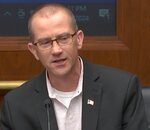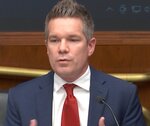

The City of Hastings took its fight against PFAS forever chemicals in its drinking water wells to the Capitol last week.
Hastings Mayor Mary Fasbender and Public Works Director/Engineer Ryan Stempski joined State Rep. Shane Hudella of Hastings in testifying before the Minnesota House Capital Investment Committee on Monday, April 15.
Hastings is hoping for a sizeable investment from the Minnesota Legislature to help it start its ambitious project to build three treatment plants to service its six wells to remove PFAS-related contamination and nitrates. The Hastings Veterans Home’s well is also contaminated with PFAS and will tie into the treatment system.
The state Department of Health recently adopted new Environmental Protection Agency standards that lowered maximum of allowable PFAS contamination in drinking water to 4 parts per trillion. That means Hastings, and other communities in similar situations, have five years to fix the problem.
Hastings has “shovel ready” plans to build the three treatment plants and is hoping to start construction on the first treatment plant as soon as possible this year. The Hastings delegation said the city would need $20 million to get the first treatment plant built. The city has received grant money to design the project.
The city is hosting a public meeting with representatives of the Minnesota Pollution Control and Minnesota Public Health agencies Thursday, May 9 at 6 p.m. in the Hastings High School Auditorium for citizens to learn more about the Hastings water situation and PFAS contamination.
Hudella addressed the House committee first.
“As of last week, our water is now unsafe to drink (by the new EPA standards). We’re about 1.5 miles downstream from the 3M plant in Cottage Grove, and somehow our community was not included in the 3M settlement. Where we’re at today, is every one of our six water towers have pollutants in it to the point that I just got my notice from the city in the mail today that our water is no longer safe to drink,” said Hudella.
With the price tag close to $70 million, it’s not feasible to do the three treatment plants at once, said Hudella.
“The city has done a great job trying to phase this over a number of years. But it’s a big investment. It’s a big investment for not only our constituents and Hastings, but last year, the state of Minnesota invested over $70 million in the Veterans Home in our community that has a 2:1 match by the federal government. It’s a $237 million project and our veterans in town are going to be connecting to the same polluted water if we can’t figure out a solution.”
Hudella closed, “We’re super hopeful that we can get some help from the state. We’re ready to go on the project. We want to get the first phase going, but we need a little bit of help.”
Fasbender told the committee, “Clean and safe water is our number one priority. Hastings’ entire water supply has been compromised, which means all 23,000 of our people are feeling unsafe drinking their water. We as the city and Public Works have done everything we can at this point.”
Fasbender called Hastings’ need for state money “urgent.”
Stempski went into some detail on the plans, which include the three decentralized treatment plans and watermain that connects the plants to the city distribution system. He said the plants will use “tried and true treatment methodologies, the granular activated carbon for PFAS and ion exchange vessels for the nitrate removal.”
“As Rep. Hudella mentioned, the project has a unique feature in that we have an interconnect designed to the Hastings Veterans Home that would bring clean, safe drinking water to nearly 150 veterans and over 100 staff members,” said Stempski. “The project is shovel ready. We are currently in design and plan to be ready for construction bidding this summer. We’re here not asking for temporary treatment plants, we’re not asking for bottled water. With the EPA rule promulgation that happened last Wednesday, we are in a mode to deliver the full in-perpetuity design, the complete project.”
He said the city is committed to spending $1 million annually to operate the treatment plants, but it can’t afford the outlay of nearly $70 million.
“This is really a budget buster for our water rates. Our water rates would really need to be doubled in two years, tripled in four years, and that would continue as a 250% increase over the next 10 years placing Hastings’ water rates atop the metro and among the highest in greater Minnesota,” Stempski said.
He reported to the committee on work being done to trace PFAS to 3M.
“The Minnesota Geologic Survey has found and mapped fault lines that run deep under the Mississippi River and across the river into Hastings, and there has been fingerprinting from a proprietary PFAS product from 3M Cottage Grove found in one Hastings well,” said Stempski. “We understand the budgets are tight at the state just like they are at the city of Hastings, but we’re here asking for $20.6 million for phase one of the project that would stand up our first treatment plant that will be shovel ready this coming summer, and it would also connect to our Hastings Veterans Home.”
He said that if PFAS in Hastings can be tied to 3M and 3M settlement funds could be used, the state could be reimbursed the money.
“Statute allows you to do that,” said Stempski.
A Minnesota Pollution Control representative at the meeting said that in Hastings, and several other cities, there are “multiple potential responsible parties” responsible for PFAS contamination.
“One of these is potentially 3M,” he said.